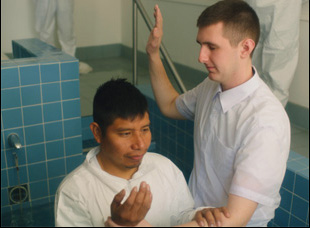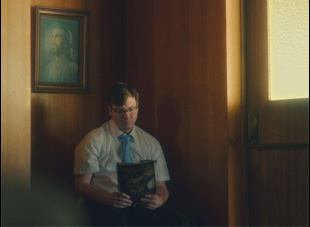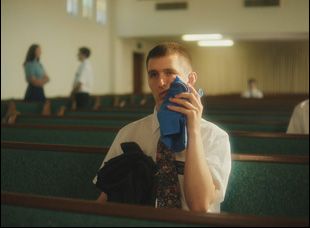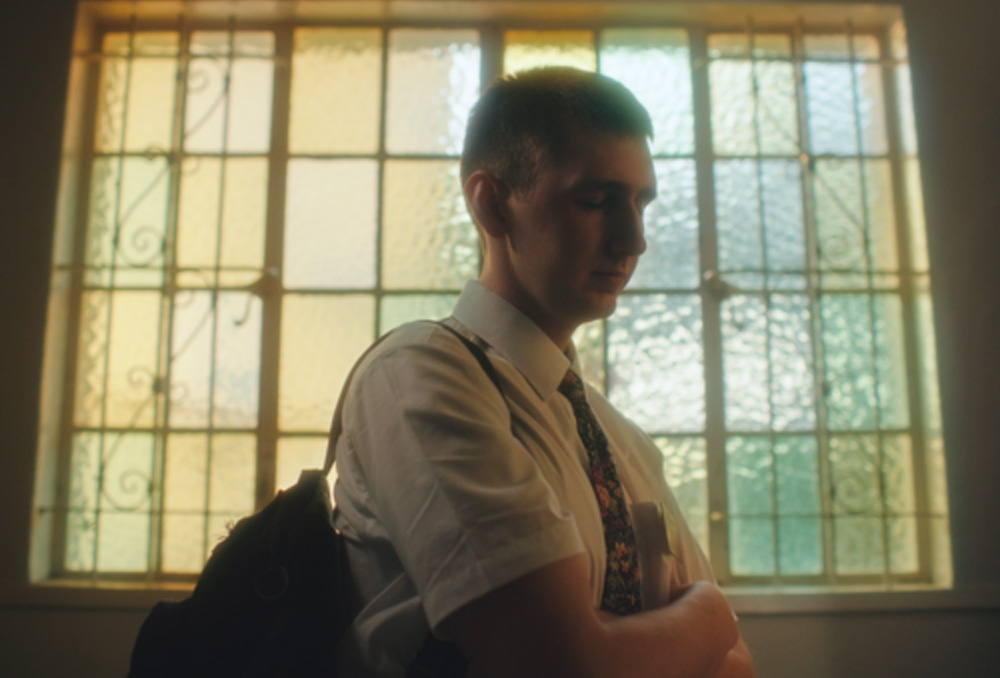There was some inherent symbolism in making sure the DVD would explode just right on the set of “The Touch of the Master’s Hand,” but in preparation for the shoot, all the discs that writer/director Gregory Barnes and his crew weren’t breaking apart in exactly the way he had hoped. The gut-busting short relies on a young Mormon missionary (Samuel Sylvester) confessing to a superior that he’s been watching something he shouldn’t have and with the scene taking place so early in the production, Barnes feared it could be a bad omen.
“We’d broken a lot of them, but they just bend and they don’t explode,” recalls Barnes, who knew that to crack up an audience the DVD would shatter perfectly. “Our production designer found one and when we were on set and [when] Samuel Sylvester first exploded the first DVD, I was very stoked. I felt like this is funny. This is the beat we need and that propelled us the rest of the shoot.”
In “The Touch of the Master’s Hand,” no detail seems too small to help push the narrative forward and Barnes, behind the camera as a director after producing many projects, makes a striking debut with the woeful tale of Elder Hyde, who can seem well out of his depth even before learning he’s had to learn a foreign language to serve out his mission in Mexico. Uncomfortable amongst his fellow missionaries in their zeal to serve the Lord, Hyde is hardly in a good place to share his most private thoughts in an interview with President Packer (Samuel Whitehall), who wants to ensure all of the young men and women at the mission are keeping in line. Every frame of the film looks like it was subject to the same scrutiny, only it unfolds as a comedy underlining the futility of denying one the ability to live out their true self and the bumpy road that often accompanies the person in question from discovering that for themselves.
Poised to be one of the most talked-about films at Sundance if the festival had been able to go on in person in the heart of Utah, “The Touch of the Master’s Hand” will now just have to offer audiences everywhere online the kind of hearty laughs that have been missing this past year with the fest going virtual. On the eve of its premiere, Barnes spoke about corralling the resources for such an impressive production, the personal inspiration for the story and how he channeled the tenets of the Mormon faith into the film’s eye-catching aesthetic.

On the most fundamental level, it was an assignment because I’m currently attending NYU and you have to make a movie for your second year. I was raised in the Mormon religion, and all Mormon men are asked to dedicate two years of their life spreading the gospel of Christ across 189 countries worldwide. But a Mormon missionary doesn’t really have any say over where they’re asked to serve, so I was called to Northern Argentina and on your mission, [you report to] a mission president, an older male who is like a patriarchal figure appointed by the prophet to oversee the affairs of a given mission, including checking on the worthiness of each Mormon missionary, asking them [things like] if they masturbate or if they’re living worthily. So I had that similar interaction, and I haven’t been Mormon for a while, but playing around with comedy, I just thought it was a great world to basically make the [central] joke of the movie.
Did you have the church in mind while writing? From what I’ve heard, it was actually built by your great-grandfather.
Yeah, it was sick. That was actually the first piece of how this came together and the final piece of the puzzle. As soon as I got permission to shoot in the Mormon church, I was just stoked and the script just came alive. Mormon stories have been rarely told in a secular way, so with access to this church, it really gave me the creative burst to have fun with this culture that I was very familiar with. I grew up in Chicago, but I have a lot of family out in L.A. and I attended this church on Sundays and went to a lot of funerals. We’re family friends with the people that oversee the congregation, so that was how we were able to get access.

Yeah, definitely with shorts, there is a scarcity of resources, so [it was helpful to] have people involved with the project that knew exactly what I was talking about when I said I need a portrait of President Nelson or like, “Hey, I need you to learn this song,” when they already half-knew it, or “I need you to act like a missionary,” [when] they’ve served a mission so they can just instinctively fall into that role. I also attended Brigham Young University for undergraduate film, and a lot of my friends I made then are still friends and have also left the Mormon church, and are also into film, so we were a ready-made crew as well [in that sense].
Just knowing how little time there often is to make shorts, it was impressive seeing how many different scenes there are in this. Did you give yourself a lot of runway to give a scope to this?
Yeah, shorts are very difficult. You got 12 minutes, but getting access to a Mormon church was a dream come true, so I was certainly motivated to try to tell a concise story but also show off the location as much as I could. The location is Mormonism as well, so letting the building speak and define the color palette of the film [was important when] these Mormon missionaries that have blended into this culture [to the point] that the main character’s having a hard time being an individual. He wants to be part of the herd. He actually feels like too much of an individual, so I just tried to anchor the story as much as I could in the elder’s perspective and keeping us with him the whole time emotionally.
What sold you on Samuel Sylvester to be your lead?
Samuel Sylvester is great. I love the guy to death. He’s actually a baker in upstate New York. He’s a non-actor and I met him through a friend of a friend. He just had the look, first and foremost, and then I could also tell he had the instincts of an actor. He’s funny, and he’s not Mormon, but he had a Catholic background so he understood what sexual shame was like [with] Catholic guilt – it’s all very similar emotions. So he showed up and he didn’t speak Spanish, but he was an Italian major, so had to learn his lines in Spanish and I think the Italian helped. He really rose to the occasion and he does a great job.

The whole idea of Mormonism is very absurd, so I felt all the Spanish spoken with a heavy English accent just really added this eeriness of what the character is feeling and also what this culture is. Personally, I still find it almost hypnotic, the way you have to listen extra hard to everyone.
Did the 4:3 Academy ratio come to mind immediately? It does a great job of creating a mild sense of claustrophobia.
There’s two reasons for the ratio — I think that ratio just looks religious. It’s very square, very restrictive, very confined. And then also growing up, I would watch a lot of propaganda Mormon VHSs. The Mormons have made a lot of moral tales [for videos], so that was certainly an influence not only for just the framing, but also the look of the film in general, trying to get filters that matched that glowing feel. Even the title of the film, “The Touch of the Master’s Hand,” comes from the very campy VHS tapes that I grew up watching that describe people as broken violins, and when Jesus plays us, we’re perfected by the touch of the master’s hand, so it was an homage to this faith I was raised in.

It’s funny you mentioned the Mormon and non-Mormon crew [before] because the shoot was a part of NYU, so there were a lot of NYU film students on set as well that didn’t have a Mormon background, and I think they were rather confused with what we were doing, whereas the people with a Mormon background did get all the jokes instantly. [laughs] We really made strong visual decisions at the outset, and it’s very simple coverage, and it all came together quite nicely. Our editor Jordan Michael Blake did a great job stitching all the moments that were tonally concise together.
Of all the films at Sundance, it does break my heart that this won’t be screening for a huge audience in the middle of Utah, but what’s it like getting into the festival and seeing it go out into the world?
I’m very happy to be playing this film festival and being part of this great film community. It is a bummer that it’s not going to be in a theater, but I’m hoping down the line that something can be put together and honestly I’m stoked this year with the online distribution platform of Sundance this year, more people can see it than usual and it’s more readily visible.
“The Touch of the Master’s Hand” will be available to stream through the Sundance Film Festival as part of the Shorts Program #4 beginning January 28th at 7 am MT.




